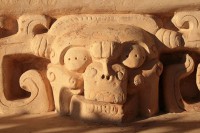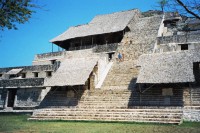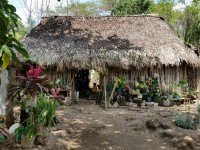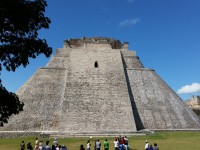 On this 3-day Yucatan Round-Trip, you’ll see the real Mexico. You’ll visit Ek Balam, Chichen Itza, and Uxmal, as well as the colonial city Merida. You will swim in cenotes to refresh yourself and go on a round trip over the famous Paseo de Montejo in Merida. You’ll stay over 2 nights in a hotel in Merida, close to the Zocalo, and you can see a reenactment of the Maya ball game or any other event on the day we are there. You'll visit a chocolate factory. where they make chocolate based on 3000-year-old Mayan recipes and you'll visit a Maya family in a Mayan village deep in the jungle to see how they go about their life!
On this 3-day Yucatan Round-Trip, you’ll see the real Mexico. You’ll visit Ek Balam, Chichen Itza, and Uxmal, as well as the colonial city Merida. You will swim in cenotes to refresh yourself and go on a round trip over the famous Paseo de Montejo in Merida. You’ll stay over 2 nights in a hotel in Merida, close to the Zocalo, and you can see a reenactment of the Maya ball game or any other event on the day we are there. You'll visit a chocolate factory. where they make chocolate based on 3000-year-old Mayan recipes and you'll visit a Maya family in a Mayan village deep in the jungle to see how they go about their life!
Day 1
 Ek Balam (Mayan for "black jaguar").
Ek Balam (Mayan for "black jaguar").
The earliest traces of settlement date back to the period between about 100 and 300 AD. Ek Balams heyday was between 700 and 1000 AD. A double ring of walls over 1.25 square km big surrounds the enclosed center of Ek Balam. The settlement outside the walls covers an area of almost 12 km ². Ek Balam is dominated by the building, today usually called Acropolis, whose old name in inscriptions is specified as Sac Xoc Naj (White House of Learning). It is undoubtedly the largest surviving building of the Mayan culture in the north of the Yucatán Peninsula. The building occupies a rectangular area of 160 m in length and 70 m in width. The highest component project today 31 m above the ground, but was originally about 6 m higher. The fourth level of the building is dominated by a huge snake mouth entrance in stucco relief that let the standing stone slab figures, outstanding of the façade, look fully three-dimensional.
 Cenote
Cenote
On your way to Merida you'll stop at a Cenote for a refreshing swim. The Cenote is situated deep in a Mayan village and operated by the Maya community. The water is crystal clear, they have bathrooms, and changing rooms and offer life vests free of charge. There is a well-made wooden staircase going down to the Cenote. After Ek Balam a welcome refreshment!!
 Lunch
Lunch
The restaurant where you'll have lunch is situated above the Cenote in the middle of the jungle, also operated by the Maya community of the village. You can order one of the tasty Maya foot options from the menu.
 Merida
Merida
After check-in at your Hotel in Merida downtown, you can explore Merida on your own and at night we'll go to the Zocalo where I will explain some historic buildings and see what daily event they offer. Afterward, we could stop off at a Restaurant for a typical Mexican dinner or you can stroll around downtown or visit a bar.
Day 2
Uxmal
Uxmal (Yucatec Maya: Óoxmáal [óˑʃmáˑl]) is an ancient Maya city of the classical period in present-day Mexico. It is considered one of the most important archaeological sites of Maya culture. Maya chronicles say that Uxmal was founded about 500 A.D. for generations Uxmal was ruled over by the Xiu family. It was the most powerful site in western Yucatán, and for a while, in alliance with Chichen Itza, dominated all of the northern Maya areas. Sometime after about 1200, no new major construction seems to have been made at Uxmal.
 Choco-story
Choco-story
You will be able to travel back in time to an ancient Mayan environment, learn how the Mayan people lived, go into their homes, cornfields, and gardens, learn about the transformation of cacao into chocolate, Observe a real Maya ceremony, drink a real Mayan hot chocolate and learn about fruits and vegetables that grow wild in the jungle.
Afterward, you{'ll stop at a restaurant where you can have a real Maya lunch, cochinita pibil or pollo pibil, pork or chicken cooked in a ground pit and seasoned with achiote, a spice from the jungle Mayans are using for thousands of years.
 Chocolate Factory
Chocolate Factory
Learn why Cacao had more value to the Mayans than gold, and learn why the Maya chocolate is really healthy, contrary to our chocolate!!! and have a taste of real Mayan chocolate. The factory is a small family business where they make chocolate by hand after 3000-year-old Maya recipes, learn everything about the history and production of Maya chocolate, have a taste of the different flavors, and if you want you can even buy some of the chocolate.
Day 3
 Chichen Itza (in the mouth of the Itza spring)
Chichen Itza (in the mouth of the Itza spring)
Chichen Itza is located about 400 km west of Cancun and is probably the most famous Mayan ruin city in the Yucatan. Chichen Itza, founded around 400 A.D, had its heyday from 800 to 1200 AD and was the center of political, religious, and military power in the Yucatan. Chichen Itza was a very large Mayan city with many inhabitants, who lived scattered around the religious zone that we now know as the ruins. Despite the large population, there was plenty of drinking water from many leading water caves and cenotes in the region. On a tour of the city, you will learn about the history of the Maya and Chichen Itza.
 Lunch
Lunch
After your visit to Chichen Itza, you'll have lunch at a beautiful Maya build & operated restaurant, on the shores of a big lagune. They offer besides typical Maya also typical Mexican food that you can enjoy with a beautiful view over the big lagune.
 Maya Family
Maya Family
Visit the family in the house, learn how they make their tortillas and how they live, and go about their life in the jungle. After lunch, you'll drive to a Mayan village deep in the jungle to visit a Mayan family at their home. They will show you how they live in the jungle, their medicinal garden, and their beehives. You can make tortillas with them and eat the tortilla you just made with some scrambled eggs and chaya (Maya spinach). The family produces also some handicrafts, like blouses or the typical Mayan dresses Huypil) for children with beautiful embroidery. From the seeds spider monkeys throw down after eating the fruit, the Mayans pick them up and make beautiful jewelry like key chains ad other souvenirs from it. The family also produces honey with the stingless Maya bee Melipona, which produces honey with high medicinal value. The family wants you to know that nobody should feel obligated to buy their handicrafts, everybody is welcome to visit and they will gladly show their way of life in the jungle!!
See more photos in our gallery.
Details
What is included?
- transportation
- entrance fees
- 2 nights at hotel in Merida
- lunch
- guides
What is not included?
- tips
- drinks at lunch
- dinner
What to bring?
- bathing suit
- towel
- sun lotion
- bug spray
- closed shoes
- pocket money
Availability
Pricelist
| # PERSONS | PRICE per Person |
|---|---|
| 1 | $ 2399.00 |
| 2 | $ 1299.00 |
| 3 | $ 1069.00 |
| 4 | $ 829.00 |
| 5 | $ 799.00 |
| 6 | $ 729.00 |
| 7 | $ 699.00 |
| 8 | $ 549.00 |
Interested?
Related Tours










